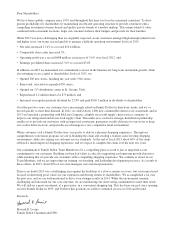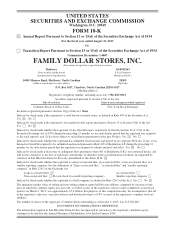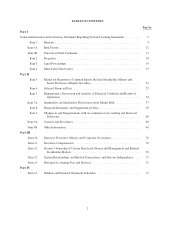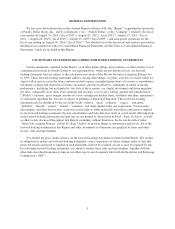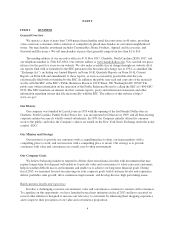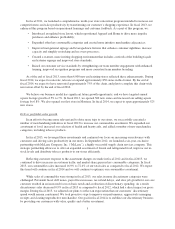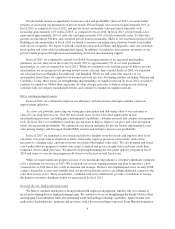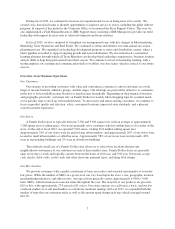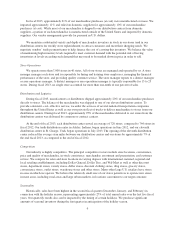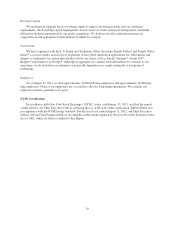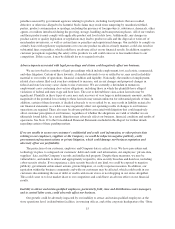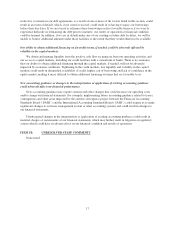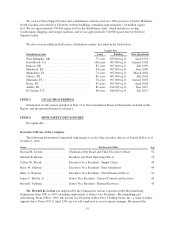Family Dollar 2013 Annual Report Download - page 13
Download and view the complete annual report
Please find page 13 of the 2013 Family Dollar annual report below. You can navigate through the pages in the report by either clicking on the pages listed below, or by using the keyword search tool below to find specific information within the annual report.In fiscal 2013, approximately 21% of our merchandise purchases (at cost) were manufactured overseas. We
imported approximately 11% and relied on domestic suppliers for approximately 10% of our merchandise
purchases (at cost). While most of our merchandise is shipped to our distribution centers from domestic
suppliers, a portion of such merchandise is manufactured outside of the United States and imported by domestic
suppliers. Our vendor arrangements provide for payment in U.S. dollars.
We maintain a substantial variety and depth of merchandise inventory in stock in our stores (and in our
distribution centers for weekly store replenishment) to attract customers and meet their shopping needs. We
negotiate vendors’ trade payment terms to help finance the cost of carrying this inventory. We balance the value
of maintaining high inventory levels required to meet customer demand with the potential risk of having
inventories at levels exceeding such demand that may need to be marked down in price in order to sell.
Store Operations
We operate more than 7,900 stores in 46 states. All of our stores are managed and operated by us. A store
manager manages each store and is responsible for hiring and training store employees, managing the financial
performance of the store, and providing quality customer service. The store manager reports to a district manager
or area operations manager. A district manager or area operations manager is typically responsible for 15 to 25
stores. During fiscal 2013, no single store accounted for more than one-tenth of one percent of sales.
Distribution and Logistics
During fiscal 2013, manufacturers or distributors shipped approximately 20% of our merchandise purchases
directly to stores. The balance of the merchandise was shipped to one of our eleven distribution centers. To
provide consistent, cost- effective service, we enlist the services of several national transportation companies
throughout the United States as well as our own private fleet of trucks to deliver merchandise to stores from our
distribution centers. During fiscal 2013, approximately 95% of the merchandise delivered to our stores from the
distribution centers was delivered by common or contract carriers.
At the end of fiscal 2013, each distribution center served an average of 720 stores, compared to 744 stores in
fiscal 2012. Our tenth distribution center in Ashley, Indiana, began operations in June 2012, and our eleventh
distribution center in St. George, Utah, began operations in July 2013. The opening of the eleventh distribution
center reduced the average stem miles between our distribution centers and our stores by approximately 7% at
the end fiscal 2013, as compared to the end of fiscal 2012.
Competition
Our industry is highly competitive. The principal competitive factors include store locations, convenience,
price and quality of merchandise, in-stock consistency, merchandise assortment and presentation, and customer
service. We compete for sales and store locations in varying degrees with international, national, regional and
local retailing establishments, including Dollar General, Dollar Tree, and Wal-Mart as well as other discount
stores, department stores, variety stores, dollar stores, discount clothing stores, drug stores, grocery stores,
convenience stores, outlet stores, warehouse stores and other stores. Many other large U.S. retailers have stores
in areas in which we operate. We believe the relatively small size of our stores permits us to operate new stores
in most areas, including rural areas and large urban markets, in locations convenient to our target customer.
Seasonality
Historically, sales have been highest in the second fiscal quarter (December, January, and February) in
connection with the holiday season, representing approximately 27% of total annual sales over the last five fiscal
years. Our quarterly results also can be impacted by the timing of certain holidays. We purchase significant
amounts of seasonal inventory during the first quarter in anticipation of the holiday season.
9


